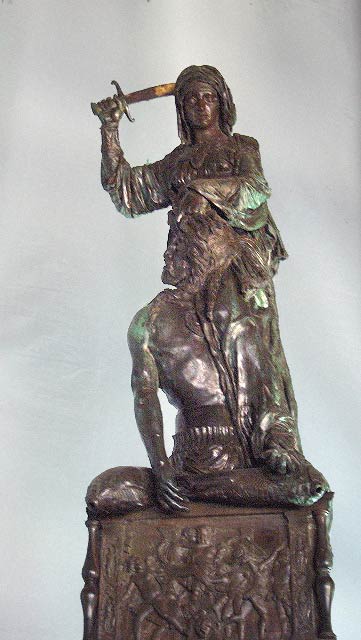| Judith and Holofernes | |
|---|---|
 |
|
| Artist | Donatello |
| Year | 1460 |
| Medium | Bronze |
| Location | Palazzo Vecchio, Florence |
| Dimensions | 93 in |
| 236 cm | |
| Famous Artwork by Donatello | |
| Saint Mark | |
| Zuccone | |
| The Feast of Herod | |
| David | |
| Equestrian statue of Gattamelata | |
| Judith and Holofernes |
Judith and Holofernes is a bronze sculpture created by the Renaissance Italian painter and sculpture known as Donatello. It was completed in the year 1460 which was towards the end of his career. It was originally commissioned by Cosimo de’ Medici to be placed as an adornment to the fountain in a Palazzo Medici-Riccardi garden. It is one of two Donatello statues standing in the palace along with David. Both depict tyrant slayers. Together, they are considered two of the earliest of any Italian Renaissance free standing statues. Judith and Holofernes can currently be viewed at the Hall of Lilies in the Palazzo Vecchio in Florence, Italy, which is also the sculptor’s birthplace.
The Artwork
The statue itself portrays Judith, the heroine from the Book of Judith, assassinating Assyrian general Holofernes. She is shown as strong and powerful grasping Holofernes by his hair with her sword poised for the downward motion that will spell his demise. The attention of observers to this artwork is immediately drawn to it due to the gilding (coating with gold) of the bronze. This technique creates a shiny reflection from daylight and especially so on sunny days. While age has deteriorated this effect, some gilding remains present to this day.
Meaning
Judith symbolizes victory by the weak over the strong for a just cause. Both virtue and liberty are also meanings present in this statue. It also believed to represent Florentine liberty with its original, but no longer visible, inscription relating to kingdoms and cities, the prior falling through luxury and the latter rising through virtue.
Art Form
Born of the Renaissance Era, Judith and Holofernes focuses on naturalism as was the case with most of Donatello’s creations. This statue was one of the first to employ an “in the round” (360 degree) method of sculpture, accurately displaying four unique faces.